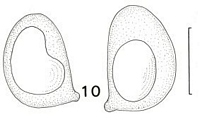|
 Clavaria rubicundula Clavaria rubicundula
BiostatusOccurrence uncertain
Images (click to enlarge)
Caption: Fig. 10. Clavaria cf. rubicundula, spores, TENN no. 43695 Scale bar=5µm. |
Article: Petersen, R.H. (1988). The clavarioid fungi of New Zealand. New Zealand Department of Scientific and Industrial Research, Bulletin 236: 170 pp. Wellington:.
Description: Fruit bodies up to 7 cm high, up to 4 mm thick, simple clubs, gregarious to fasciculate in
groups of up to 25 individuals, narrowly fusiform, curved-ascending, dull rosy pink all over.
Club opaque, appearing waxy; apex rounded. Stipe concolorous with club, differing only in
subglabrous texture.
Tramal hyphae up to 18 µm diam., thin-walled, clampless, inflated, constricted at primary
septa, short-celled, parallel; secondary septa common; wall thickened in narrow transverse
bands here and there; gloeoplerous hyphae rare, uninflated, highly refringent.
Subhymenium poorly developed. Hymenium thickening; basidia 55-65 x 7.5-9 µm, clavate,
clampless, 4.5-5 µm thick at base; contents multiguttulate at maturity, the guttules small and
highly refringent; sterigmata 4, short, spindly.
Spores 6.8-8.3x4.7-5.4 µm (E = 1.33-1.62; Em 1.46; Lm = 7.52 µm), ovate to ellipsoid,
smooth, flattened adaxially, thin-walled; contents uniguttulate when mature; hilar appendix
small, papillate, not prominent.
Habitat: >On humus.
Notes: When I first collected this, I thought it was the same as Clavaria roseo-violacea, for both
form clumps of pink fruit bodies. I noted the colour as the same as C. rubicundula, with
which I am familiar from North America. As a result, accurate colour notes are not available.
Moreover, the specimen was old when collected, and most fruit bodies broke in transit from
field to laboratory.
I can find no good reason to separate this from Clavaria rubicundula, which fruits in eastern
North America from Michigan and the Canadian maritimes to the southern Appalachian
Mountains. I would have no hesitation with such a distribution pattern if the taxon were
reported from locations between North America and New Zealand, but I know of no such
reports. Nonetheless, because I cannot separate the two taxa, I include the New Zealand
specimen under the name hitherto reserved for North American material.
A single collection has been made of a taxon with simple fruit bodies of similar colouration
to Clavaria rubicundula and with identical micromorphology. Fruit bodies were up to 45 x 3
mm, not as brittle as those of C. rubicundula, with stipe portion pallid pinkish flesh ("pale
pinkish cinnamon") and glabrous, and club pallid violet-grey ("vinaceous buff"). No
branching or fasciculation were seen. The stipes were pruinose with a white "bloom" at the
base. Whether this specimen represents a separate taxon cannot be ascertained until more
collections are made.
|